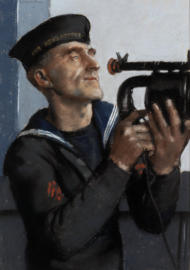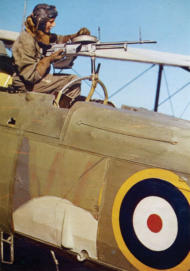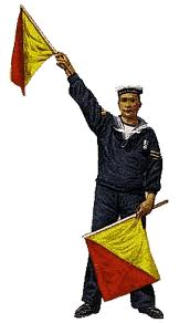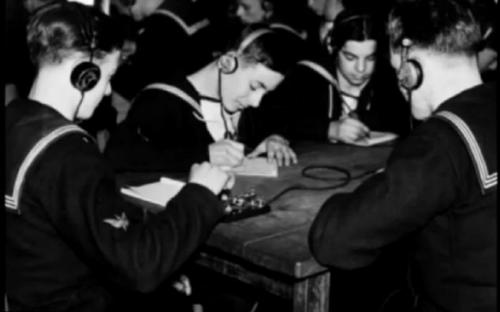Remembering the Telegraphist Air Gunners

East Camp Instruction - Telegraphist Air Gunners
The training of Telegraphist air Gunners was intense. TAG pupils arriving at the Camp for their nine months of training were
usually given a few days to ‘settle in’ while Instructors got them organized.
The Instructors were often selected because of their experiences as Air Gunners and that experience was only to be gained by
being ‘on active service’ in some squadron or other. Most were ‘permanent’ Royal Navy with pre-war experience; however, some
instructors were ‘hostilities only’ men.
There were Chief Petty Officers sent to Yarmouth in 1942 so they were experienced personnel.
The instructional day was divided into four training sessions: two in the morning, and two in the
afternoon. Sometimes two were merged into one long, or double, session. There would be about
forty pupils per course. An instructor would be in charge of them, usually a Petty Officer or a Chief
Petty Officer assisted by acting as his second help, if available.
Session 1 might have one course on W/T (wireless telegraphy) theory being taught by a school master.
Session 2 would have another course on gunnery instruction, learning what guns were used in
aircraft, when, why and how, theory, and then learning to strip the gun, whether it be a gas-operated
Browning or Lewis gun.
There were three or four classrooms, so several courses would be on session 1 at the same
time, but taking different lessons and subjects with different instructors. Session 3 might be Morse
training and session 4 could be P. T. (physical training). At the end of each session they would change
around. One particular course in two days could have done, for example: Morning - W/T theory and
P.T; Afternoon – Gunnery and Morse practice. The next day, there could be P.T. in the morning and
flying training in the afternoon.
Other instructional training would have included aircraft handling, visual signalling, semaphore,
and Aldis lamp exercises. Or, W/T procedure, learning what to do when the enemy was sighted,
which priority signals to use. There were different priority signals for an enemy destroyer to an
enemy battleship, for example. The Telegraphist Air Gunner trainee had to learn how to
communicate with other airborne aircraft, the call signals of ships, the call signals of a squadron, or
of your aircraft carrier. They would learn how to signal to their carrier, and what to do if wireless
telegraphy silence was in force. They had to learn how to operate and maintain the homing beacon
in the aircraft if the plane was lost. Then there would be instruction on different types of wireless
telegraphy transmitters and receivers. They had to learn how to do a quick repair whilst flying if
there were problems. They reviewed how to change wavelengths, how to use the aerial, care of
batteries, and the daily inspections that Telegraphist Air Gunners had to do on their own aircraft for
which they alone were responsible. They studied the care and maintenance of wireless telegraphy
equipment on the ground, in tropical and cold climates. TAG pupils were made familiar with the
different types of ammunition, when to use them, or tracer bullets, etc. and the loading and
reloading of the magazines. They learned where the bombs and torpedoes were stored in the
aircraft and how they were released. Parachute instruction, putting the harness on, and getting it off
quick if ditching in the sea was also studied; along with where the dinghy was stowed on the aircraft.
There would be instruction in the classroom on Morse exercises. They had to learn to read Morse signals up to about 12-15
words per minute. First the pupils had to learn the Morse Code, and then they were started off at a slow rate working up as they
progressed to a faster speed.
There was a standard printed form for the Morse exercises that had to be used. On this form
the first exercise would be a paragraph in plain English, taken from a book, for example, where
‘bright’ pupils could guess the word before it was completed.
The next paragraph, of about ten lines, would be plain language (words) but foreign words,
usually French, where they could not guess what the coming word might be. There would be a set of
code (four letter blocks) followed by cypher (five figure blocks) and the exercise would end with four
or five typical signals sent out by an aircraft on spotting enemy ships.
This four session arrangement obviously gave time off to some of the Instructors, who would
then, for example, spend the period in marking the previous day’s buzzer exercise, or in writing up
notes for the next day’s work. Those pupils who were ‘behind’ had to have extra buzzer lessons to
keep them up with the class in general, and an Instructor would be detailed for this job in the
evenings.
Then there were exams papers to set, both half way through the course and the final exam. These papers had to be marked,
and checked, and the results sent down to the Administration office. The Instructors may have had meetings with Commander
Mudie, Commanding Officer, to discuss whether to
allow a borderline pupil to pass or ‘dip’ (fail). The
general character and behaviour of the TAG would
carry many a pupil through if he was a borderline
case.
The Instructors and the training Officers took
their work seriously and at times it was hard work
getting the knowledge through to the pupils who also
worked hard and who, after all, were not all equally
receptive to learning strange skills.
There were other activities for which Instructors
were responsible. They had to see to the health of
the trainees, sick parades, etc. They had to make
sure the mens’ beds and dormitory were neat and
clean for inspections. There were reports to be made
up of the progress and behaviour of the pupils. Instructors had to see that pupils were dressed correctly, and that they were
‘kitted out’ with all their flying gear.
Some pupils would report that something was mislaid or stolen and the instructors had to sort that out. They had to attend to
‘this and that’ on behalf of the trainees and as one Instructor put it, “I say we had to be ‘mothers’ to them. They were all young
(and innocent?) and were away from home for the first time. But on the whole, they were all a good lot and really no trouble.”
Not all instructors were Course Instructors. Some were gunnery Instructors and did nothing but that. Others were Tarmac
Instructors, responsible for the aircraft handling, for example that the sets in the aircraft were properly set and functioning, etc.
The School Masters were all Warrant Officers and taught other subjects besides W/T theory. A senior Chief Petty Officer might
take the pupils for instruction of the sets in the aircraft, or on the theory of squadron procedure, call signs, and how to word
signals in the ‘official navy fashion’, etc.
Instructors had other jobs to do in and around the Camp: Duty Petty Officers or Duty Chief in the Sergeants Mess, or attend
meetings where instructors were given new instructional material to pass on to the pupils.
The Instructors were in cabins, two sharing, and these were made as comfortable as possible. There would have been two
beds and two tables where they did marking of papers. The cabins had a radio and various other home comforts. On the wall was a
week schedule [Monday - Friday, Saturday and Sunday squared off so instructors knew in advance when they were required and
which Course they were instructing].
Some Instructors also manned the Wireless Telegraphy hut, where there were several transmitters and receivers to send and
receive Morse signals from the pupils when they were out flying in the Swordfish and Anson aircraft. This usually occurred near the
end of training.
There was an Annapolis (Kentville) W/T route and a South Shore route towards Lunenburg and Chester Basin. Each pupil in
his aircraft on the ground had first to receive his ‘T.O.’ (Take Off) signal and then regularly had to receive messages from East Camp
to transmit his ‘received signal’ using his own call sign and then to keep in contact throughout the flight. Each separate aircraft
would receive signals from the East Camp base and the TAG pupil had to listen out for his own call sign on the air, receive that
signal and then act on it. Marks were given for his speed of acknowledgement, his accuracy of Morse transmitted, and his distance
from Camp.
The school at East Camp was located four miles from the town of Yarmouth. During the time of East Camp (1942 -1945)
Yarmouth was a typical small maritime town. It consisted, basically of one main street with an assortment of shops and offices, a
Court House, theatres, drug stores, garages and a liquor store where one could buy the month’s supply of beer or spirits. Yarmouth
had no pubs, in the British tradition. There was a radio station, CJLS, a hospital, newspapers, and fire and police departments.
The RCMP also had a station located in Yarmouth. The railway stations were located along Water Street, near the harbour.
Air Training exercises were flown from the school and TAG pupils became familiar with names like Hectanoogo, Digby,
Annapolis, Bridgetown, Liverpool, Shelburne, Cape Sable and Tusket.
When the Camp closed in March 1945, TAG pupils and Instructors, for the most part, returned to England.
Sources:
Recollections of an Instructor by Doug Hemingway, East Camp RCAF Station Yarmouth Nova Scotia (R.H. Reed; 1984)

IWM Collections (Art.IWM ART LD
2690): Leading Signalman J G Burton
: signalling with an Aldis lamp, "HMS
King George V"




copyright © Wartime Heritage Association
Website hosting courtesy of Register.com - a web.com company
Wartime Heritage
ASSOCIATION


- World War I - Menu
- WWI Stories and Articles
- Photos - Yarmouth Soldiers
- Selection of World War I Songs
- WWI Casualties of Yarmouth, NS
- Those Who Served - Yarmouth, NS
- WWI Casualties Digby Co. NS
- WWI Casualties Shelburne Co. NS
- Merchant Mariners (1915) Yarmouth, NS
- Canadian Forestry Corps - Non Yarmouth Birth/Residence Enlistments
- US Draft Registry - Yarmouth NS Born


- World War II - Menu
- WWII Stories and Articles
- Telegraphist Air Gunners
- WWII Casualties of Nova Scotia
- US Casualties with NS Connection
- Far East/Pacific Casualties with NS Connection
- Merchant Navy Casualties Nova Scotia
- Nova Scotia WWII Casualties Holten Canadian War Cemetery
- D-Day Casualties - Nova Scotia
- CANLOAN Program Casualties - Nova Scotia
- Battle of the Bulge Casualties - Nova Scotia
- WWII Casualties Yarmouth NS
- Yarmouth Casualties - RCAF RAF Canadian Army WWII
- Yarmouth Co., Marrages WWII
- Casualties Non-Born/Residents with Connection to Yarmouth Co., Nova Scotia.
- WWII Casualties Digby Co., NS
- Non-Nova Scotian WWII Casualties Buried in Nova Scotia
- WWII RCAF Casualties Aged 16-18
- Brothers/Sisters Who Served - World War II













